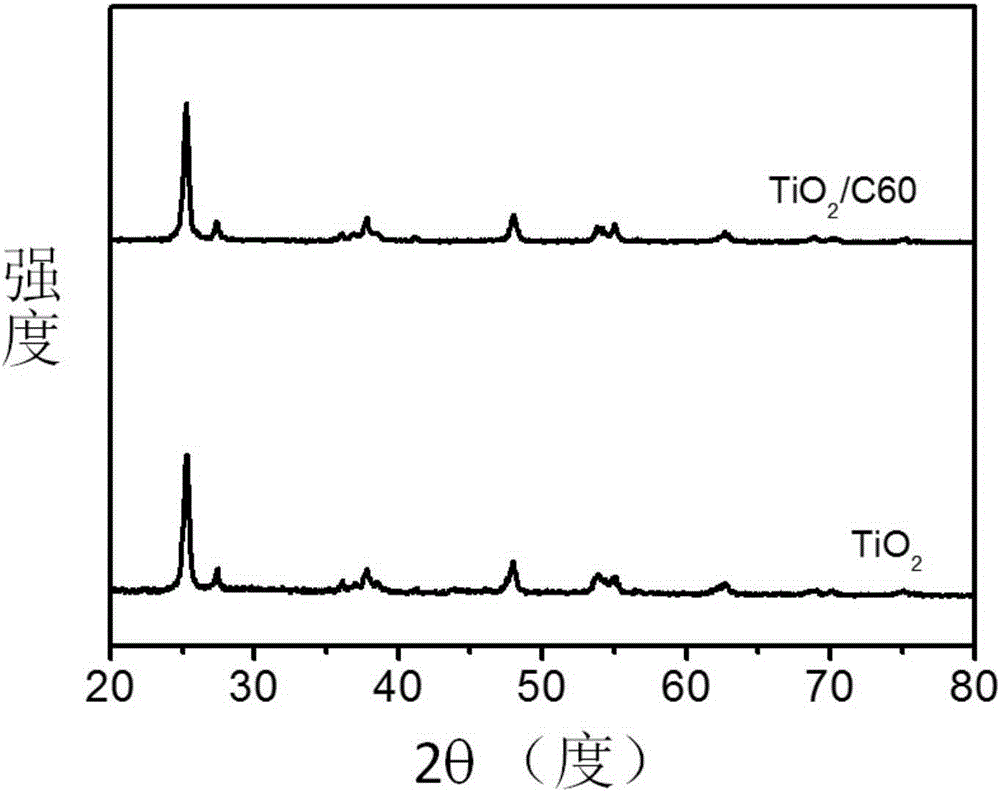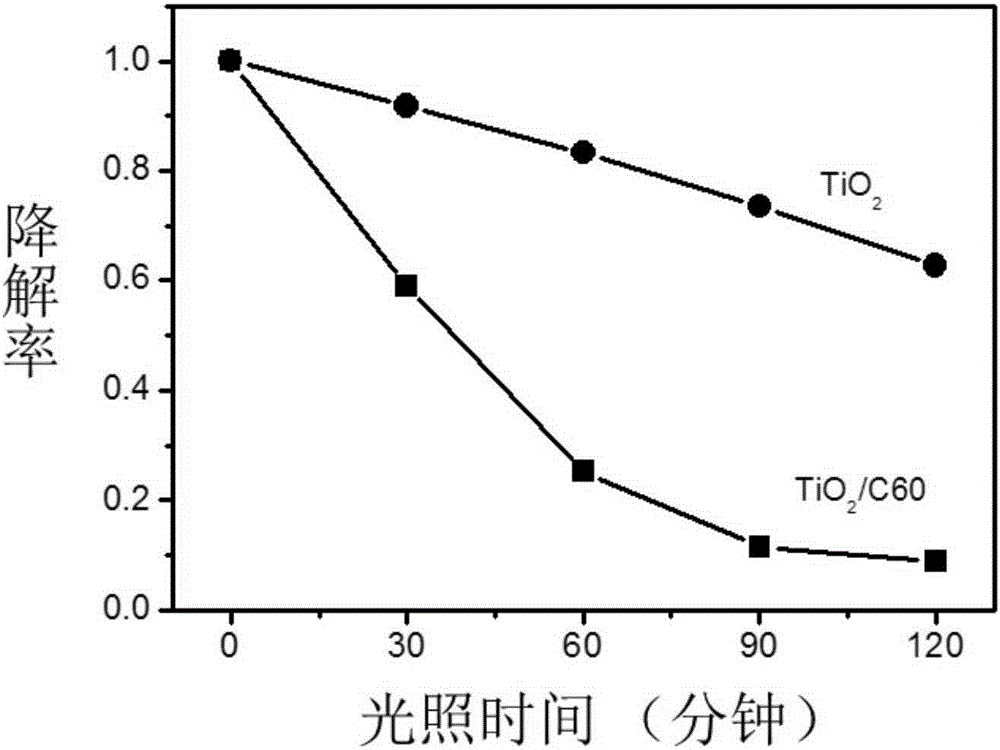Preparation method of fullerene-doped titanium dioxide visible-light-driven photocatalyst
A technology of titanium dioxide and fullerene, which is applied in the field of preparation of fullerene-doped titanium dioxide visible light catalyst, can solve the problems of complex process, poor catalyst adsorption performance and visible light catalytic performance, and achieve strong photocatalytic activity and strong adsorption capacity Effect
- Summary
- Abstract
- Description
- Claims
- Application Information
AI Technical Summary
Problems solved by technology
Method used
Image
Examples
Embodiment 1
[0024] Preparation of carboxyl functionalized fullerene derivatives:
[0025] In a 100 ml single-necked volumetric flask, add 0.072 g of C60, 0.15 g of p-carboxybenzaldehyde, 0.089 g of sarcosine and 30 ml of toluene, and reflux at 115° C. for 10 hours under nitrogen protection. The solvent was removed by a vacuum rotary evaporator, the obtained solid was washed with water, and dried to obtain a carboxyl-functionalized fullerene derivative. Characterized by MALDI-TOF-MS, a series of mass spectrum peaks were observed at molecular weights ranging from 1253.6 to 2320.7, corresponding to 3-9 carboxyl substituents.
Embodiment 2
[0027] Fullerene-doped titanium dioxide visible light catalyst TiO 2 Preparation of / C60:
[0028] 20 mg of carboxyl functionalized fullerene derivatives (Example 1) and 1 gram of titanium dioxide (P25-TiO 2 ) was dispersed in 50 milliliters of dehydrated ethanol, and the gained solution was dispersed by ultrasonic waves for 30 minutes, and the solvent was slowly removed by rotary evaporation, and the obtained solid was dried in a vacuum oven to obtain fullerene-doped titanium dioxide (TiO 2 / C60) photocatalyst. Measure the wavelength range of absorbed light by diffuse reflectance absorption spectroscopy ( figure 1 ). It can be clearly seen that the TiO prepared by the present invention 2 The absorption spectrum of / C60 photocatalyst is better than that of undoped TiO 2 It has been extended to the visible light region (>400nm), indicating that the prepared catalyst has stronger visible light absorption performance. Visible by XRD characterization ( figure 2 ), the cry...
Embodiment 3
[0030] TiO 2 Visible-light catalytic degradation of rhodamine B dyes by / C60 photocatalyst:
[0031] Get 10 milligrams of the photocatalyst of the present invention (embodiment 2), join 10 milliliters concentration and be in the rhodamine B solution of 10 milligrams per liter, oscillate ultrasonically for 5 minutes, store in the dark place for 1 hour until the adsorption-desorption equilibrium, place Irradiate under a xenon lamp equipped with a 400-nanometer ultraviolet filter; pipette the mixed solution every 30 minutes, centrifuge, take the supernatant and measure the absorbance with a UV-visible spectrophotometer to calculate the concentration of residual rhodamine B, and pass The degradation rate was calculated by the ratio of the dye concentration at different irradiation times to the initial concentration before irradiation. The comparison results show that the TiO prepared by the present invention 2 / C60 photocatalyst is more active than undoped TiO 2 Higher, degrada...
PUM
 Login to View More
Login to View More Abstract
Description
Claims
Application Information
 Login to View More
Login to View More - R&D
- Intellectual Property
- Life Sciences
- Materials
- Tech Scout
- Unparalleled Data Quality
- Higher Quality Content
- 60% Fewer Hallucinations
Browse by: Latest US Patents, China's latest patents, Technical Efficacy Thesaurus, Application Domain, Technology Topic, Popular Technical Reports.
© 2025 PatSnap. All rights reserved.Legal|Privacy policy|Modern Slavery Act Transparency Statement|Sitemap|About US| Contact US: help@patsnap.com



